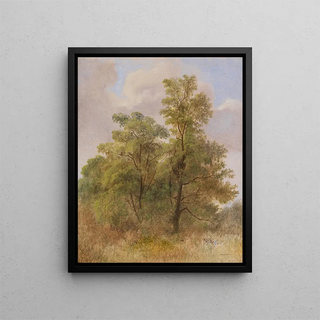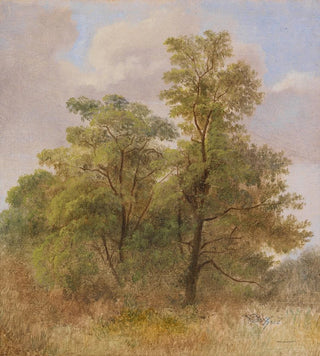Art print | Study of Trees - Carl Spitzweg


View from behind

Frame (optional)
In the enchanting universe of romantic art, the "Art print of trees study" by Carl Spitzweg stands out for its charm and visual poetry. This delicate representation of nature invites viewers to immerse themselves in a world where the vegetal comes to life under the artist's brush. The trees, majestic and serene, stand with timeless grace, bearing witness to the harmony between man and his environment. The piece, both simple and complex, evokes an atmosphere of tranquility that resonates deeply with those who take the time to observe it. It is an invitation to contemplation, a suspended moment where the eye is lost in shades of green and play of light.
Style and uniqueness of the work
The originality of "Art print of trees study" lies in its ability to capture the ephemeral beauty of nature. Spitzweg, through his meticulous style and refined details, succeeds in creating an ambiance that is both realistic and dreamlike. The tree trunks, finely crafted, seem to tell ancient stories, while the foliage, light and airy, suggests a gentle dance with the wind. The color palette, subtle and harmonious, plays a key role in the emotion conveyed by this work. The deep greens, earthy browns, and touches of light create a vivid, almost tangible tableau. This art print is not limited to a simple botanical representation; it is an ode to nature, a celebration of its diversity and beauty.
The artist and his influence
Carl Spitzweg, an emblematic figure of the 19th century, managed to mark his era with his unique approach to art. Born in 1808 in Munich, he initially pursued a career in pharmacy before fully dedicating himself to his passion for painting. Spitzweg is often associated with the Romantic movement, a current that advocates the expression of emotions and the valorization of nature. His influence extends well beyond his time, inspiring many artists to explore themes of solitude, contemplation, and natural beauty. Through his works, he established a dialogue between man and his environment, inviting everyone to rediscover

Matte finish

View from behind

Frame (optional)
In the enchanting universe of romantic art, the "Art print of trees study" by Carl Spitzweg stands out for its charm and visual poetry. This delicate representation of nature invites viewers to immerse themselves in a world where the vegetal comes to life under the artist's brush. The trees, majestic and serene, stand with timeless grace, bearing witness to the harmony between man and his environment. The piece, both simple and complex, evokes an atmosphere of tranquility that resonates deeply with those who take the time to observe it. It is an invitation to contemplation, a suspended moment where the eye is lost in shades of green and play of light.
Style and uniqueness of the work
The originality of "Art print of trees study" lies in its ability to capture the ephemeral beauty of nature. Spitzweg, through his meticulous style and refined details, succeeds in creating an ambiance that is both realistic and dreamlike. The tree trunks, finely crafted, seem to tell ancient stories, while the foliage, light and airy, suggests a gentle dance with the wind. The color palette, subtle and harmonious, plays a key role in the emotion conveyed by this work. The deep greens, earthy browns, and touches of light create a vivid, almost tangible tableau. This art print is not limited to a simple botanical representation; it is an ode to nature, a celebration of its diversity and beauty.
The artist and his influence
Carl Spitzweg, an emblematic figure of the 19th century, managed to mark his era with his unique approach to art. Born in 1808 in Munich, he initially pursued a career in pharmacy before fully dedicating himself to his passion for painting. Spitzweg is often associated with the Romantic movement, a current that advocates the expression of emotions and the valorization of nature. His influence extends well beyond his time, inspiring many artists to explore themes of solitude, contemplation, and natural beauty. Through his works, he established a dialogue between man and his environment, inviting everyone to rediscover






